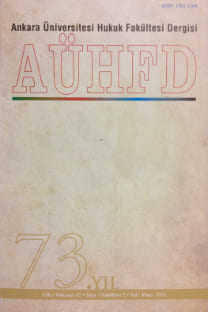DTÖ Hukuku uygulamasında ayrımcılık yapmama ilkesi
Uluslararası alanda çok taraflı ticaret sisteminin hukuki temeli 1994 yılında imzalanan Dünya Ticaret Örgütü (DTÖ) Anlaşması1 ve ekinde yer alan Anlaşmalar (DTÖ Anlaşmaları) tarafından belirlenmektedir. DTÖ, 1947 yılında geçici olarak uygulamaya konulan ve 1994 yılına kadar uygulanan Gümrük Tarifeleri ve Ticaret Genel Anlaşması’nın (GATT 1947) yerini almıştır. Bununla birlikte, DTÖ Anlaşması, GATT 1947 hükümlerini yürürlükten kaldırmamış, tam tersine 1947 sonrasında yapılan müzakere turları ile kaydedilen gelişmeleri de içerecek şekilde, GATT 1994 altında bünyesine katmıştır. DTÖ Anlaşması’nın yürürlüğe girmesi ile birlikte dünya ticareti, DTÖ şemsiyesi altında yer verilen ve yaklaşık 60 anlaşma, ek, mutabakat ve karardan oluşan hukuki bir zemin üstünde şekillenmiştir. Söz konusu hukuki yapının temel yapıtaşını ise Ayrımcılık Yapmama İlkesi oluşturmaktadır. En Çok Kayrılan Ülke ve Ulusal Muamele kurallarından oluşan bu ilkenin tanımı ve uygulaması basit gibi gözükmekle beraber, uygulamanın bu ölçüde basit olmadığı Panel ve Temyiz Organı raporları incelendiğinde açıkça görülmektedir. Diğer yandan, söz konusu kurallardan sapmaya olanak sağlayan istisna kurallarının varlığı uygulamayı daha da güçleştirmektedir. Bu çerçevede, DTÖ’ye 26 Mart 1995 tarihinde üye olan Türkiye açısından Ayrımcılık Yapmama İlkesi’nin DTÖ hukukundaki uygulamasının anlaşılması gerek dış ticarete ilişkin mevzuatın hazırlanması ve gerekse Türkiye’nin taraf olabileceği muhtemel bir panelde haklarımızın savunulması açısından önem taşımaktadır.
The principle of nondiscrimination in WTO law
The legal basis of the multilateral trading system in the international arena is determined by the Marrakesh Agreement Establishing the World Trade Organization (WTO) and its Annex Agreements (The WTO Agreements). The WTO superseded the General Agreement on Tariffs and Trade (GATT 1947), which had been put into place provisionally, but applied until 1994. Nevertheless, provisions of the 1947 GATT agreement were not revoked by the WTO Agreement; on the contrary, together with the developments made during the negotiation rounds made after 1947, they were incorporated into the 1994 WTO Agreements. With the entry into force of the WTO Agreemenst, world trade has been shaped on a legal basis, consisting of about 60 agreements, annexes, understandings and decisions provided under the WTO umbrella. The principle of nondiscrimination forms the basis of this legal structure. Although the definition and application of this principle, which is composed of the Most Favored Nation (MFN) and National Treatment rules, seems simple, the complexity of the implementation is realized apparently when the Panel and Appellate Body reports are examined. In addition, existence of the exceptions, leading to deviation from these rules, makes the implementation more complex. In this regard, understanding the application of the nondiscrimination principle in WTO law is crucial for Turkey, which joined the WTO on 26 March 1995, when preparing its legislation on foreign trade and defending its rights in a possible panel.
___
- Bahala R., Modern GATT Law, A Treatise on the General Agreement on Tariffs and Trade; Sweet and Maxwell, London 2005.
- Bossche P.V., The Law and Policy of the World Trade Organization, Cambridge University Press, 2005.
- Cottier T, Oesch M; International Trade Regulation Law and Policy in the WTO The European Union and Switzerland; Cameron May ltd. London; 2005.
- Davey W.J., Pauwelyn J., MFN-Unconditionally: A Legal Analysis of the Concept in view of its Evolution in the GATT/WTO Jurisprudence with Particular Reference to the Issue of “like Product”, Regulatory Barriers and the Principle of Non-Discrimination in the World Trade Law; Editors Thomas Cottier and Petros C. Mavroidis, The University of Michigan Pres, 2002.
- Dış Ticaret Müsteşarlığı (DTM), Bölgeselleşme ve Çok Yanlı Ticaret Sistemi Çelişkisi, Dünyada ve Türkiye’de Ekonomik Gelişmeler Dergisi, Sayı 7, 2001.
- Differential and More Favorable Treatment Reciprocity And Fuller Participation of Developing Countries, Decision of 28 November 1979 (L/4903).
- GATT, Analytical Index: Guide to GATT Law and Practice, Updated 6th Edition, 1995.
- Jackson J.H., World Trade and the Law of the GATT, published by The Bobbs-Merrill Company, 1969.
- Jackson J. H., The World Trading System Law and Policy of International Economic Relations, Second Edition, Massachusetts Institute of Technology (MIT) Press, 1997.
- Matsushita M., Schoenbaum T.J, Mavroidis P. C.; The World Trade Organization Law, Practice and Policy, Oxford University Press, 2003.
- Pazarcı H., Uluslararası Hukuk, Gözden Geçirilmiş 6. Bası, Turhan Kitapevi, Ankara, 2008.
- Rossler F., Chapter 6 Diverging Domestic Policies and Multilateral Trade Integration, The legal Structure, Functions & Limits of the World Trade Order, A Collection of Essays, Cameron May, 2000.
- Sutherland P, Bhagwati J., Botchwey K., FitzGerald N, Hamada K., Jackson J.H.; Lafrer C., Montbrial T, The Future of the WTO: Addressing Institutional Challenges in the New Millennium, Report by the Consultative Board to the Director-General Supachai Panitchpakdi, World Trade Organization, 2004.
- Telli S, Devletler Hukuku Açısından Uluslararası Ticaret ve Kurumsallaşması, Banka ve Ticaret Hukuku Araştırma Enstitüsü Yayını, Sevinç Matbaası, 1991.
- Trebilcock M. J. and Howse R., The Regulation of international Trade 2. Ed. Routledge, 2001.
- Yılmaz M., Dünya Ticaret Örgütü Kuralları Açısından Sübvansiyonlar ve Telafi Edici Tedbir Soruşturması, Türkiye Odalar ve Borsalar Birliği Yayını, 2005.
- World Trade Organization, Understanding the WTO, Fourth Edition, 2008.
- www.dtm.gov.tr.
- www.wto.org.
- www.worldtradelaw.org.
- ISSN: 1301-1308
- Yayın Aralığı: Yılda 4 Sayı
- Başlangıç: 1943
- Yayıncı: Ankara Üniversitesi Hukuk Fakültesi
